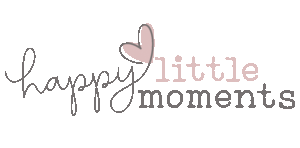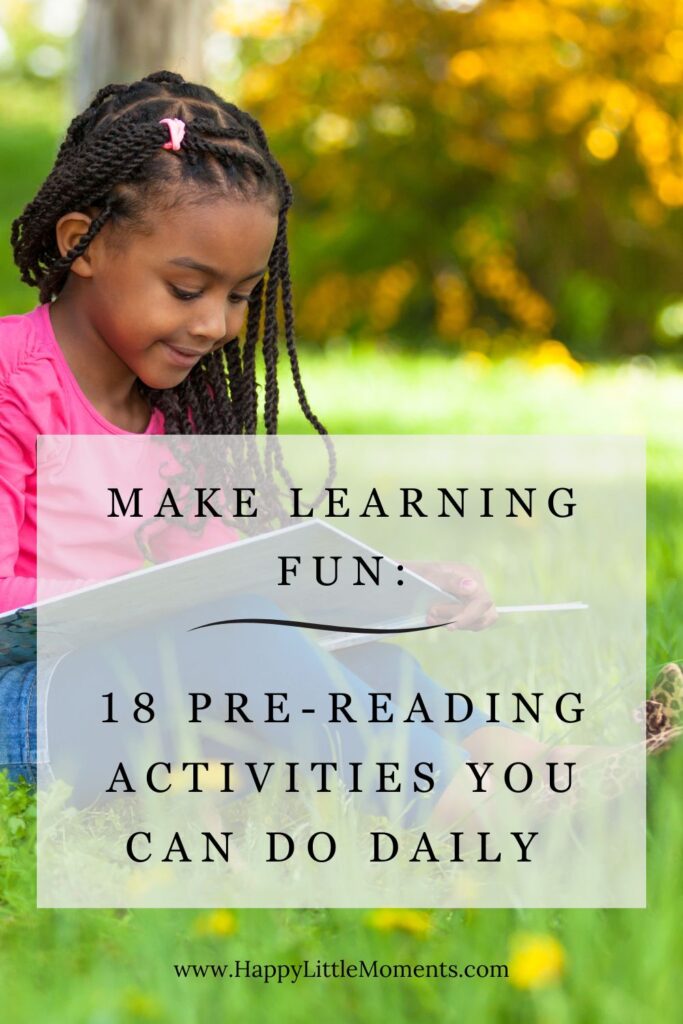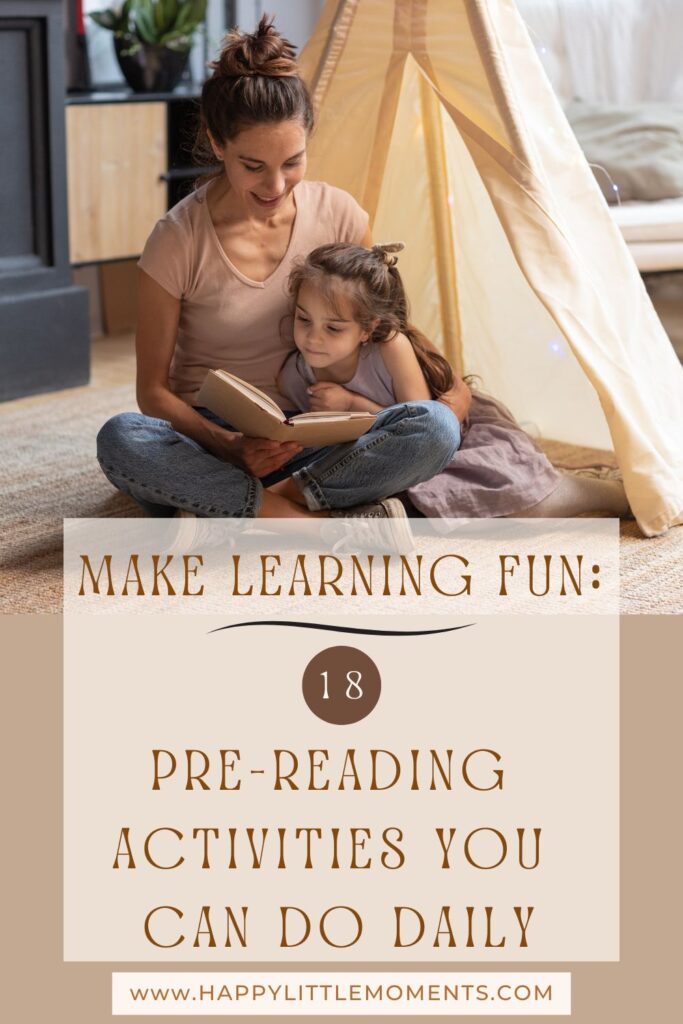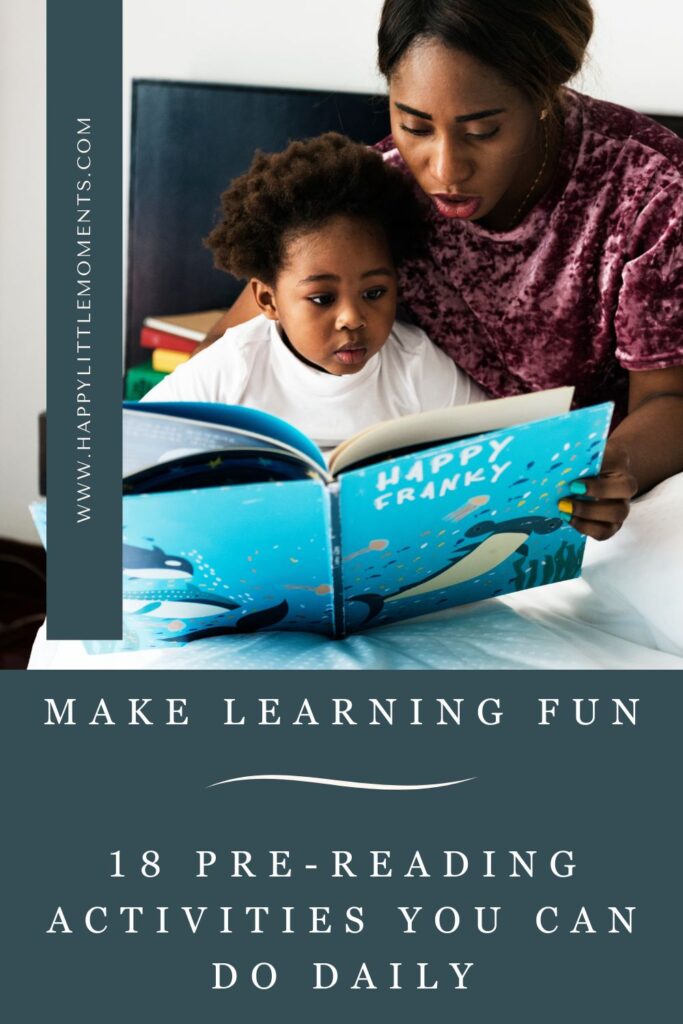happy little moments





18 Pre-Reading Activities You Can Do Daily with Your Child
Looking for easy pre-reading activities to create a love of reading in your child? Pre-literacy activities are a fun and natural way to build essential skills that lay the foundation for lifelong literacy, and the best part is—they can be easily included in your daily routine.
Pre-literacy skills are crucial to children’s success in school, learning to read, and even their success out in the working world as adults. It’s important for kids to learn to read because it helps with self-esteem throughout school, helps them continuously learn as adults, and helps them stay informed and able to take on new challenges into adulthood. This one skill can often make or break adulthood. Many high school graduates are still illiterate at graduation. And many more students aren’t reading at a high school graduate level at the time of graduation.
That’s a disturbing statistic – let’s make Gen Alpha better by helping them early with the pre-literacy skills they need to succeed in life.
What are pre-ready activities You can do with your child?
Often, parents don’t think they have the skills to teach their children to read. However, you don’t need to know the mechanics of it all. There are some very simple things you can do to encourage your child to develop pre-reading skills in preschool and toddlerhood. Singing and saying nursery rhymes with your child is a very effective start to teaching pre-reading skills to your child. Reading each night before bed has an incredible effect on your child’s ability to learn vocabulary, retain information, and get familiar with words in print. Also, playing simple pre-literacy games with your child can help your child make huge leaps toward literacy.
I want to empower you with some easy pre-reading activities to prepare your child for kindergarten and become an excellent reader. We all want our children to have happy and successful lives. So, I’ve compiled a list of activities you can do with your child during the day or in the evening to help them on a reading path forward.
18 Pre-Reading Activities
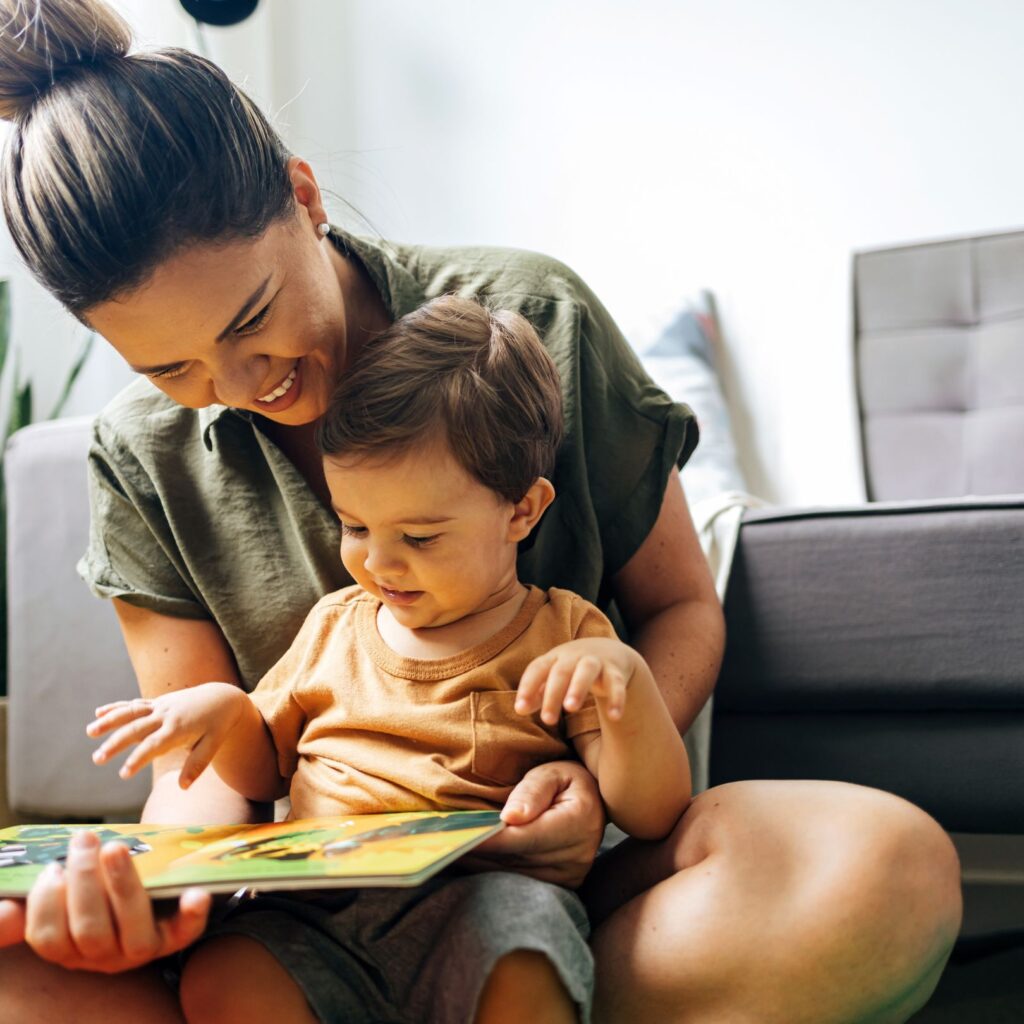
1. Read to Your Child Daily
Reading to your child before bed every night (or any time daily) can dramatically increase your child’s pre-reading skills. They will learn new vocabulary, begin to understand story structure, improve their comprehension and listening skills, and learn to love reading books. When reading to your child, feel free to be silly! Kids love it when you use different voices and expressions to keep the story fun and engaging.
2. Go to the Library
Libraries are known to be literacy-rich environments with lots of print everywhere. They have endless books and literary activities every month. Check out your library’s schedule, go to Storytimes, and frequently choose new books to read together in the evening. Exposing your child to lots of stories, new vocabulary, and fresh books starts them off on the right path toward learning to read in school.
3. Point Out Words
When reading a story to your child, point to each word as you read it. You can also point out a specific word and emphasize the letter sounds in that word. Have your child repeat each sound to you, essentially “sounding it out.” Saying each letter sound and then blending the sounds together helps them make the phonological connections for reading. Doing this simple activity while reading is a great introduction to phonics for your young child.
4. Improve Story Comprehension and Memory
After reading a book, have your child repeat the story back in their own words. At first, they may need a little help, but having them retell the story will give you a better idea of how well they comprehend and retain the story and will test their ability to sequence. By practicing retelling stories, your child will build narrative skills, improve sequencing skills, and help with their ability to memorize.
5. Get Alphabet Magnets
Children LOVE magnets! Have your child play with alphabet magnets on your refrigerator. Alternatively, if you prefer a clear fridge, stick the magnets on a cookie sheet. With alphabet magnets, children get familiar with all the letter symbols, you can work with them on letter sounds, and they can start creating words independently.
Pre-Reading Activities: Art and Music
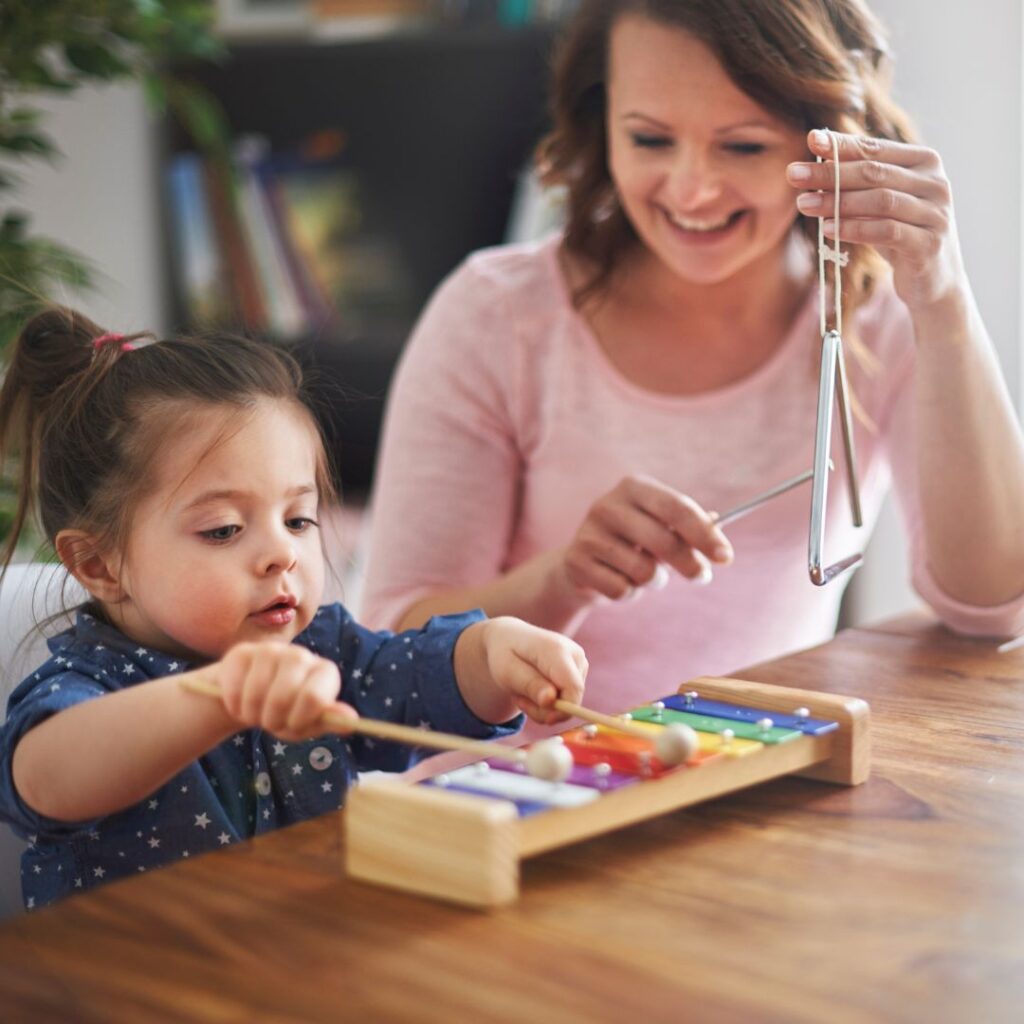
6. Sing Songs and Nursery Rhymes
Singing naturally promotes learning phonological awareness, which is foundational to literacy. Through songs and rhymes, children learn to recognize rhymes, patterns, and rhythms. Additionally, while singing, each vowel sound is elongated, making words easier to hear and understand. Songs can even help with speech, as the child must elongate their vowels and can learn to enunciate their consonants.
Nursery rhymes are also helpful during this early literacy phase. These simple little rhymes help children learn to recognize phonological patterns and rhyming. Even learning just eight nursery rhymes by the age of four increases the chances that your child will be a better reader and speller in school.
7. Drawing and Scribbling Stories
Encourage your child to draw out “stories” or to “write” their own story. They don’t need to be able to write letters to do this activity, nor do they need to be able to draw well. Drawing a “story” helps your child’s fine motor skills, builds imagination, and uses drawing as an expression. This is also a fantastic activity to help your child process big emotions, too. Once they’re finished, you can label their drawing and hang it on the refrigerator.
8. Clap Out Syllables
Practice clapping out the syllables of the words you say or hear. This pre-reading activity helps your child build more sound awareness, slows down the words, and helps them hear each syllable clearly. This builds phonological skills which are important for learning to read in Kindergarten.
9. Sing the Alphabet Song
Sing the alphabet song frequently with your toddler or preschooler. Make it part of your handwashing or teeth-brushing routine. By making it fun, your child will memorize the alphabet song in no time!
Pre-Reading Activities: Games
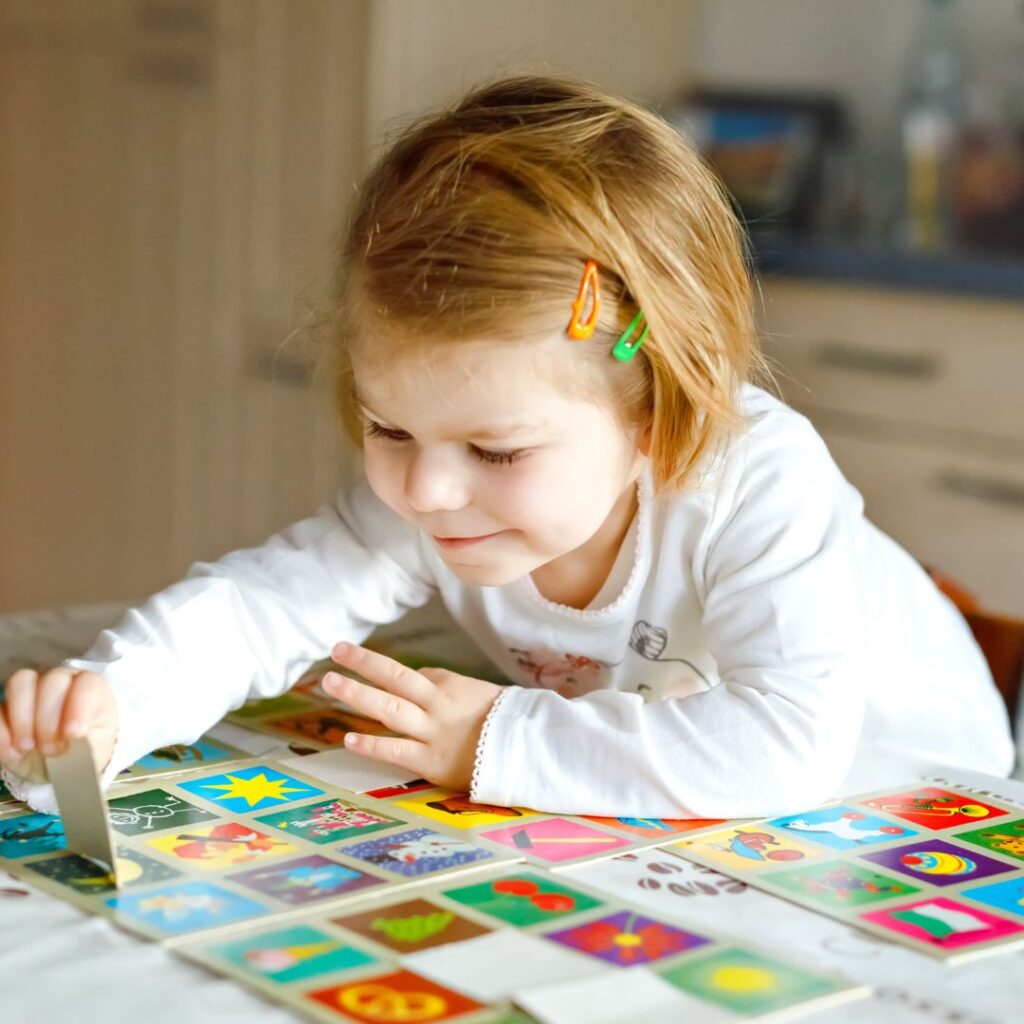
10. Letter Scavenger Hunt
Hide letter cards or letter magnets around the room and have your child find them. Make sure to say the name of the letter and the sound it makes. It’s important for children to begin to understand that each letter has both a name and a sound associated with it.
11. Play Matching Games
Playing matching games will help build your child’s visual memory, which helps them down the road with learning sight words. Remembering pictures, symbols, and numbers are important skills in literacy. While I’m a huge advocate for learning phonics in addition to sight words, most of us adults have memorized the words we read on a daily basis. This simple little skill of memorization is quite important when it comes to learning literacy skills in Kindergarten.
12. Sound Scavenger Hunt
Send your child on a scavenger hunt to find items that start with a certain letter. For instance, if you say, find objects that start with the letter “P,” your child can find a plant or the pots and pans in your home. If your child loves to play games with you, this is a great way to gamify learning letters and beginning word sounds.
13. I-Spy with Letters and Sounds.
Play “I-Spy” but have your child find something that starts with a letter. For example, “I spy something that starts with the letter ‘C.” Then have your child guess things around the room that start with “C.” Playing I Spy this way will help your child learn letters, sounds, and It’s just a fun little game to play with them.
14. Make a Name Puzzle
Make a puzzle using the letters of your child’s name. This will help them start to recognize and arrange the letters in their name in the correct order. To help them associate other words with letters, you can buy puzzles like this for your preschooler.
Ways to Make Your Home Literacy friendly
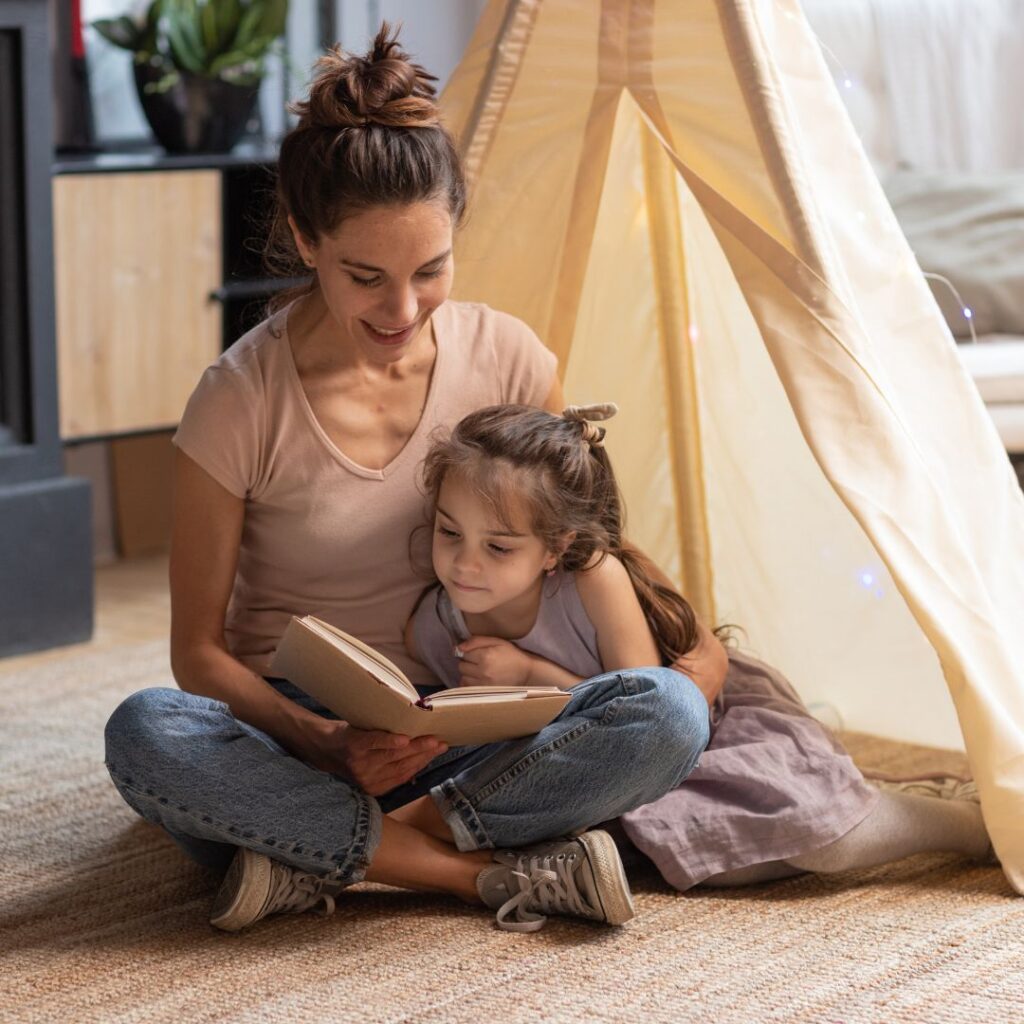
15. Create a Cozy Area in Your Home.
Find a corner or quiet nook in your home where you can put a comfy child-sized chair and a small blanket. Then place a small basket of books there. I did this in my home over the summer, and I’ve been surprised how often my kids go over there and take a peek at the books on their own. Don’t forget to refresh the books in your cozy nook often so they keep coming back!
16. Label Objects in Your Home
Grab your label maker! Label objects around your house so your child can learn those words quickly by sight. You can label common words such as “chair,” “table,” “door,” “shelf,” or “oven.” This helps with visual memory, learning print, and connecting written words with real-life objects. This is a great prerequisite to learning sight word flash cards in Kindergarten and First Grade.
17. Create “Book time” in Your Routine.
Adding a daily book time to your routine is a good way to build up the habit of reading every day. Creating book time just means having a little quiet time when everyone settles in with a good book and a blanket for a short period of time. This can even be an amazing way to transition your child away from having naptime the summer before Kindergarten. This gives them a little down time instead of naptime. During your daily book time, you don’t necessarily have to read to your child. Just have everyone look at books at the same time each day.
18. Let them see you reading!
Did you know that 70% of adults read only 1 book or less a year? Yikes! Don’t be that parent! Let your kids see you reading – you can read a novel, biography, or a book about a new skill you’d like to learn. Just let them see you reading every day. This will encourage your child to want to read because they see that it brings value and joy to the adults in their life.
Bonus: Reading on your own daily can help you learn a new skill or even get a job promotion. Pick something that genuinely interests you or something you really want to learn. You’ll pick up a new skill set over time, and inspire your children to follow in your footsteps!
Being an active part of your child’s reading journey will help them have more of an interest in reading in the future. Sparking an interest in reading is truly the first step in literacy, which you can work to establish during the toddler and preschool years. I hope this helps give you some solid ideas to make pre-reading activities fun, engaging, and gives you another way to bond with your child. Before you know it, you’ll have a successful early reader in kindergarten – maybe even sooner!
